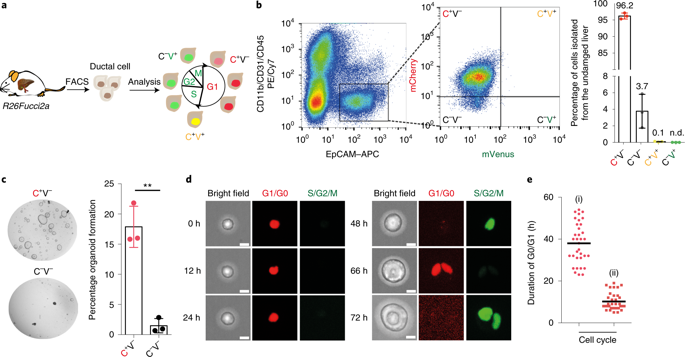当前位置:
X-MOL 学术
›
Nat. Cell Biol.
›
论文详情
Our official English website, www.x-mol.net, welcomes your
feedback! (Note: you will need to create a separate account there.)
Epigenetic remodelling licences adult cholangiocytes for organoid formation and liver regeneration.
Nature Cell Biology ( IF 17.3 ) Pub Date : 2019-11-04 , DOI: 10.1038/s41556-019-0402-6 Luigi Aloia 1, 2, 3 , Mikel Alexander McKie 1, 2, 3 , Grégoire Vernaz 1, 4, 5 , Lucía Cordero-Espinoza 1, 2, 3 , Niya Aleksieva 6 , Jelle van den Ameele 1, 2 , Francesco Antonica 2 , Berta Font-Cunill 1, 2, 3 , Alexander Raven 6 , Riccardo Aiese Cigliano 7 , German Belenguer 1, 8 , Richard L Mort 9 , Andrea H Brand 1, 2 , Magdalena Zernicka-Goetz 2, 10 , Stuart J Forbes 6 , Eric A Miska 1, 4, 5 , Meritxell Huch 1, 2, 3, 8
Nature Cell Biology ( IF 17.3 ) Pub Date : 2019-11-04 , DOI: 10.1038/s41556-019-0402-6 Luigi Aloia 1, 2, 3 , Mikel Alexander McKie 1, 2, 3 , Grégoire Vernaz 1, 4, 5 , Lucía Cordero-Espinoza 1, 2, 3 , Niya Aleksieva 6 , Jelle van den Ameele 1, 2 , Francesco Antonica 2 , Berta Font-Cunill 1, 2, 3 , Alexander Raven 6 , Riccardo Aiese Cigliano 7 , German Belenguer 1, 8 , Richard L Mort 9 , Andrea H Brand 1, 2 , Magdalena Zernicka-Goetz 2, 10 , Stuart J Forbes 6 , Eric A Miska 1, 4, 5 , Meritxell Huch 1, 2, 3, 8
Affiliation

|
Following severe or chronic liver injury, adult ductal cells (cholangiocytes) contribute to regeneration by restoring both hepatocytes and cholangiocytes. We recently showed that ductal cells clonally expand as self-renewing liver organoids that retain their differentiation capacity into both hepatocytes and ductal cells. However, the molecular mechanisms by which adult ductal-committed cells acquire cellular plasticity, initiate organoids and regenerate the damaged tissue remain largely unknown. Here, we describe that ductal cells undergo a transient, genome-wide, remodelling of their transcriptome and epigenome during organoid initiation and in vivo following tissue damage. TET1-mediated hydroxymethylation licences differentiated ductal cells to initiate organoids and activate the regenerative programme through the transcriptional regulation of stem-cell genes and regenerative pathways including the YAP-Hippo signalling. Our results argue in favour of the remodelling of genomic methylome/hydroxymethylome landscapes as a general mechanism by which differentiated cells exit a committed state in response to tissue damage.
中文翻译:

表观遗传重塑允许成年胆管细胞形成类器官和肝脏再生。
严重或慢性肝损伤后,成体导管细胞(胆管细胞)通过恢复肝细胞和胆管细胞来促进再生。我们最近表明,导管细胞克隆扩展为自我更新的肝脏类器官,保留其分化为肝细胞和导管细胞的能力。然而,成体导管定型细胞获得细胞可塑性、启动类器官和再生受损组织的分子机制仍然很大程度上未知。在这里,我们描述了导管细胞在类器官启动期间和组织损伤后的体内经历了短暂的全基因组转录组和表观基因组重塑。 TET1 介导的羟甲基化允许分化的导管细胞启动类器官,并通过干细胞基因的转录调节和包括 YAP-Hippo 信号传导在内的再生途径激活再生程序。我们的结果支持基因组甲基化组/羟甲基化组景观的重塑作为分化细胞响应组织损伤而退出定型状态的一般机制。
更新日期:2019-11-04
中文翻译:

表观遗传重塑允许成年胆管细胞形成类器官和肝脏再生。
严重或慢性肝损伤后,成体导管细胞(胆管细胞)通过恢复肝细胞和胆管细胞来促进再生。我们最近表明,导管细胞克隆扩展为自我更新的肝脏类器官,保留其分化为肝细胞和导管细胞的能力。然而,成体导管定型细胞获得细胞可塑性、启动类器官和再生受损组织的分子机制仍然很大程度上未知。在这里,我们描述了导管细胞在类器官启动期间和组织损伤后的体内经历了短暂的全基因组转录组和表观基因组重塑。 TET1 介导的羟甲基化允许分化的导管细胞启动类器官,并通过干细胞基因的转录调节和包括 YAP-Hippo 信号传导在内的再生途径激活再生程序。我们的结果支持基因组甲基化组/羟甲基化组景观的重塑作为分化细胞响应组织损伤而退出定型状态的一般机制。











































 京公网安备 11010802027423号
京公网安备 11010802027423号